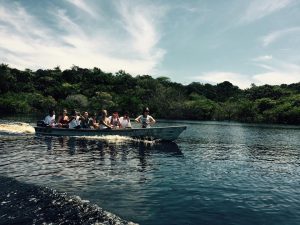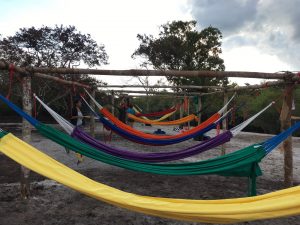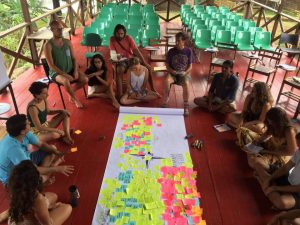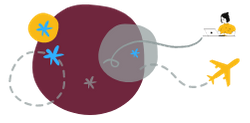Pre-departure:
Preparing for Brazil was simple; a tourist visa is granted to South African citizens on arrival for 90 days and though I came armed with documents such as my proof of address and letter of acceptance into the course, the border officials asked for none of it. Even my up to date yellow fever card was ignored – though it is a legal requirement to enter the country so do get it if you are heading there.
Flights to Brazil are not cheap, however I managed to get what I thought was a good deal. A week before I left I checked my ticket to find out that I arrived in one airport in Sao Paulo and left for Manaus (my final destination) from another one. It turns out that there are three airports in Sao Paulo and though it may be cheaper to change airports, it probably is not worth the stress. However, this was my fate and luckily I had 10 hours to do the transfer. My flight arrived Guarulhos International Airport and then my connecting flight left from Viracopos airport. There is no direct bus between the two airports so I had to get an airport bus from Gaurulhos to Congonhas airport – another airport in the city centre. The bus cost around 40 Reels and was very comfortable. There, my airline, Azul, provided a free bus service to Viracopos. Luckily, Congonhas airport is small and it was easy to find the ticket office and the bus. If you book a connecting flight that leaves from Guarulhos international airport it is worth noting that the airport is really big with 4 terminals that require a bus to get from one terminal to the next, so make sure you leave yourself enough time.
As I knew I was heading into the Amazon heat, I packed very light. So light in fact that I was able to take all my luggage as hand luggage on the way up (not on the way back however due to excessive food shopping in Manaus). The course conveners were great at sending out more than one checklist so I knew exactly what I needed to pack. Apart from the light everyday clothes, other essentials included hiking boots (though running shoes would have been sufficient), a light rain jacket, a sun hat, more than one swimming costume, a small pillow, a water bottle and mosquito repellent. I also packed thin long pants and tops that were great protection for the mosquitoes in the evenings and on jungle treks. One thing I missed was a blanket/sleeping bag as it got quite chilly sleeping outside at night.
Experience at the summer school:

Once I arrived in Manaus there was a person organised by the course conveners to pick me up and take me to the hostel. There I met my fellow course participants and had an opening day of lectures at The Sustainable Amazonas Foundation (FAS) – a conservation and community development organisation situated in Manaus. The following day we took a 2 hour boat ride on the Rio Negro, a tributary of the Amazon River, to Tumbira a community in the heart of the Amazon rain forest. This was to be our home for the next 21 days. On arrival, we were each given a brightly coloured hammock and mosquito net to sleep in. Instead of beds in our log cabins, there were hooks to hang the hammocks. The hammocks were surprisingly comfortable (so much so that I am very sorry to be back in a normal bed) and there was a covered area outside the cabin for those of us who wanted to sleep outside. Every morning I watched the sunrise over the Amazon River from the comfort of my hammock – magic.

The course itself was run in four phases – love for nature, love for people, love for yourself and bravery. Love for nature covered information on the Amazon rain forest, its biodiversity, ecosystem services, importance and threats. This section was covered over a couple of days with some of the leading experts in the field lecturing us both in the classroom and in the jungle itself. Love for people involved us getting to know the people of Tumbira – spending time in the community, visiting homes, learning how to prepare local foods and how to make local crafts and even visiting one of the monthly football matches and parties in a neighbouring community. Love for self, involved a spiritual process of getting to know ourselves in order to become affective change agents. Through art, writing, meditation and sharing with peers we each reflected on our history, who we were and who we wanted to be. The last phase, bravery, involved doing a project in the community. In this phase, we worked together with the community to help drive eco-tourism in Tumbira, develop a community vision for the future and plan a leaving ceremony to thank the people of Tumbira for their hospitality. This course was like nothing I had experienced before at Stellenbosch University. Being immersed in the jungle in a very isolated community was a unique experience. However, the anthropological, sustainable development focus of my master’s degree meant that I was well equipped to tackle the challenges posed to us on the course.

Our free time was spent getting to know the community, each other – as we were all from different parts of the world, sitting around the fire and swimming in the Amazon River. We also had the opportunity to kneeboard, go on boat rides up the river, and go for jungle treks deep in the forest and visit alligators at night. One night we spent camping far away from the village on an isolated river beach. On one of the last nights we presented the community with the work we had done and celebrated with a party full of Brazilian flair. Though it was a lot of fun, it was very sad to say goodbye to our little piece of Amazonian paradise and the incredible people who inhabit it.
Return to Stellenbosch:
I have come back to Stellenbosch with a new enthusiasm for creating change in this world. The course has given me a holistic framework to not only research problems but to help address them in a way that is both affective and fun. It has also showed me the importance of understanding who I am and what my biases are in order to be a more affective change agent.
While the context of Tumbira is very different to communities in South Africa the challenge they face is the same – how to improve people’s quality of life without harming the environment. Thus, everything I learnt from the people there and from the course has given me the tools to tackle this same problem back home. There is no one solution for this problem but there is an effective approach that enables the development of solutions that are appropriate to each differing context. This approach involves getting to know the natural landscape, getting to know the people, getting to know oneself and then using all that information to create affective change.
The course injected me with the passion to create change in my home country and I cannot wait to start implementing this both during and after my studies. However my fellow course participants have become as close as family to me and while I love South Africa, I know I will have to go to Bangladesh, the Philippines, India, Colombia, Ecuador, the United States, Canada and of course back to Brazil to visit them. There is even talk of us all going to Uganda next year to do a project so watch this space.

